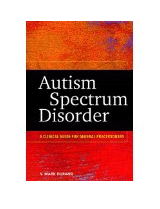“Autism Spectrum Disorder: A Clinical Guide for General Practitioners”

“Autism Spectrum Disorder: A Clinical Guide for General Practitioners”
By V. Mark Durand
American Psychological Association
Washington, D.C., 2014
Readable volume suitable for wide audience
Reviewed by James K. Luiselli, Ed.D., ABPP, BCBA-D
V. Mark Durand, a highly regarded clinician and researcher in the area of autism spectrum disorder, wrote this book “to provide background on ASD and outline decision points that help clarify when a clinician has the requisite skills to help and when a referral to a specialist is needed.” At 132 pages, it is a slim book but one loaded with information to assist a broad range of professionals in understanding ASD, contemporary best practices, and critical steps along the continuum of diagnostic evaluation, assessment, and intervention.
In two introductory chapters Durand provides an historical context for ASD, starting with the seminal work of Leo Kanner nearly six decades ago, through the most recent changes in diagnostic criteria found in the DSM-5. He very clearly defines the key elements necessary for confirming ASD, including the sometimes confusing “level of severity” category that must be assigned diagnostically. These chapters will be particularly helpful for professionals without formal training in ASD.
Any book about ASD must address epidemiology and the ongoing controversy concerning increased incidence rates. Durand references all of the purported causal factors such as revisions to diagnostic criteria over the years, greater awareness of ASD within the professional community, pressure to establish a diagnosis in order to access educational services and environmental influences. He then summarizes research on the etiology of ASD that suggests a confluence of genetic, biological, neuroscience and cognitive pathways.
Diagnostic co-morbidity is a common finding in ASD, which Durand emphasizes “speaks to the need for a comprehensive assessment beyond the presence of the symptoms of the disorder.” In essence, diagnosticians must be keenly aware of co-occurring conditions with ASD and how to properly identify them when constructing a formulation. Some of these conditions discussed in the book include intellectual disability, anxiety, mood disorders, epilepsy, and attention deficit hyperactivity disorder.
Durand’s chapter, Screening, Diagnosis, and Assessment, is one of the best in the book. It contains several tables that list standardized tools and instruments for initial screening of possible ASD, conducting a diagnostic evaluation, and assessing related skills. For each of the tools and instruments these tables and the accompanying text delineate respective age ranges, administration protocols and psychometric properties, in effect offering a handy and concise guide that will benefit any practitioner.
The last two chapters in the book deal with treatment, centering on current evidence-based and empirically supported methods for teaching skills and reducing challenging behaviors. Some of the topics Durand highlights are early and intensive behavioral intervention, building social-communicative competencies, and preventing victimization of persons with ASD in the form of bullying and stalking. As well, he examines issues of parent training and family assistance through support groups, cognitive-behavioral therapy, and advice to siblings.
This book is indeed a clinical guide for general practitioners seeking information about ASD. I give high praise to Durand for compiling an extraordinarily expansive subject matter into a highly readable volume. He deserves further credit for presenting the best and most accurate knowledge we have about ASD, as gleaned from multiple disciplines and endorsed by prominent research scientists.
Specialists in the area of ASD should recommend this book to their less experienced colleagues and other professionals in need of a “basic course” on state-of-the-art practice guidelines. I suspect that the book will also find a place in classrooms and serve as a valuable resource for students first exposed to ASD and other neurodevelopmental disorders. It is not easy writing for such a large audience and with this level of precision but Durand has accomplished both tasks impressively!
James K. Luiselli, Ed.D., ABPP, BCBA, is senior vice president, applied research, clinical training and peer review at the May Institute in Norwood, Mass.
Learn more about the book: Autism Spectrum Disorder: A Clinical Guide for General Practitioners
